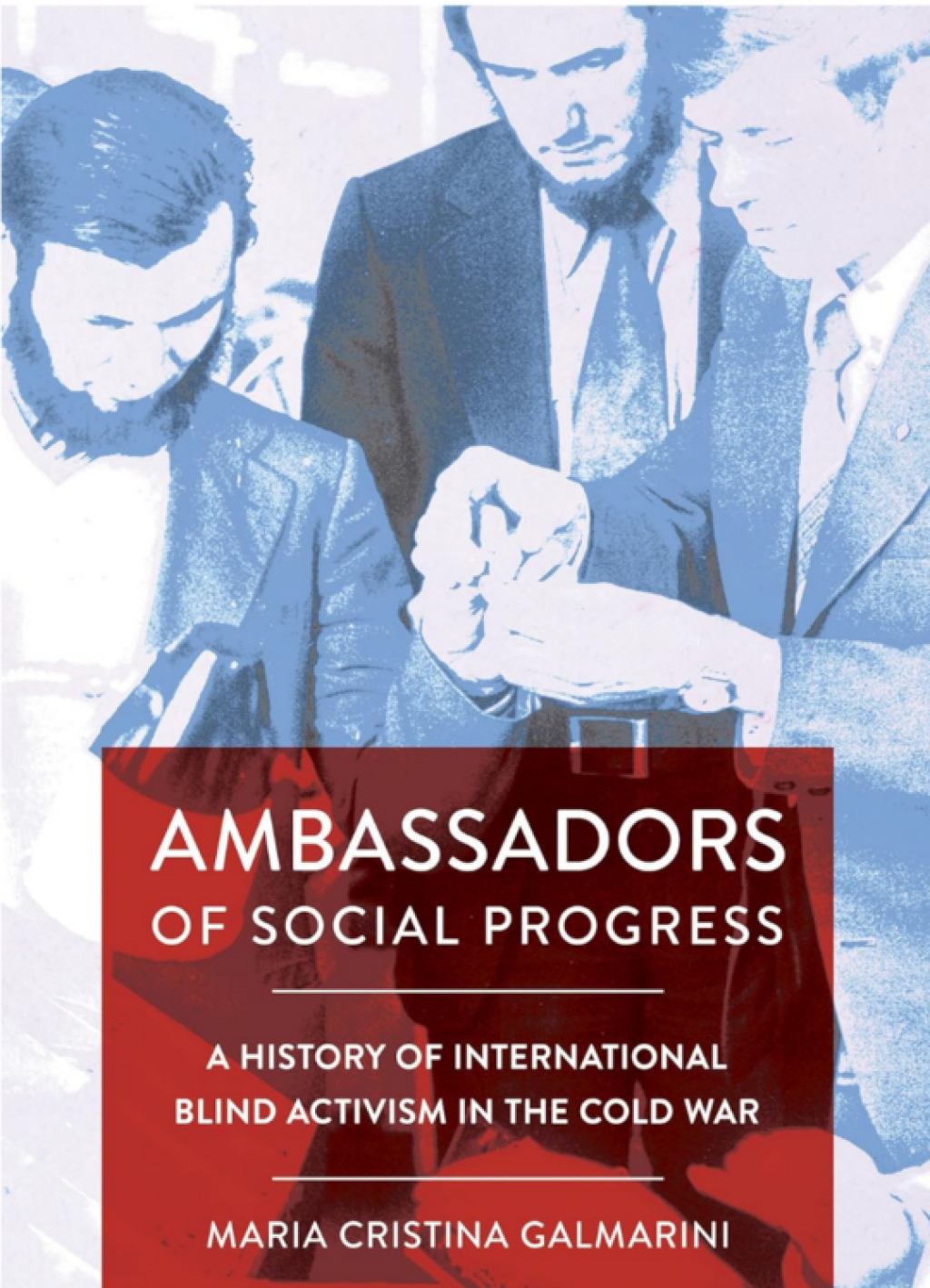This is Part I in a two-part series. Part II will run tomorrow, 4/3.
Maria Cristina Galmarini is Associate Professor in History and Global Studies at the College of William and Mary. Some material in this post is drawn from “Ambassadors of Social Progress or Obstacles to Integration?”, Chapter 6 in Ambassadors of Social Progress: A History of International Blind Activism in the Cold War, a Northern Illinois University Press book published by Cornell University Press. Copyright (c) 2023 by Cornell University. Used by permission of the publisher.
In the mid-1960s, the leaders of the All-Russian Society of the Blind (Vserossiiskoe Obshchestvo Slepykh, or VOS) were convinced that their work compared favorably to that of similar organizations in the capitalist West. The Soviet government at that time imagined itself as the champion of welfare issues, well ahead of the First World in promoting social rights. Feeling ready to show off accomplishments in their specific field of action, VOS activists eagerly took part in their country’s opening to the world. They received delegations, sent representatives abroad, and participated in international conferences in the certainty (or hope) that the progressiveness of Soviet disability advocacy would impress international audiences. Indeed, at the heyday of their global presence, Soviet activists proved to be excellent ambassadors of social progress, revealing to the entire world socialism’s achievements in matters of blind people’s agency, employment, and social security.
However, when VOS activists entered in closer contacts with their Western counterparts, some dark shadows also began to appear in the pristine image of progress that they strove to project. One was the fact that they needed to learn as much as they wanted to teach. Another – even more troubling – was the realization that the wider dissemination of VOS’s model of disability magnified not only the advantages of the socialist approach but also its inherent flaws. Although Western activists did feel great admiration for their Soviet colleagues, some of them also questioned the usefulness of Soviet methods of segregated education and sheltered employment to facilitate blind people’s integration. At international conferences, it became increasingly apparent that definitions of what was truly progressive in blind activism were a muddled terrain of debate, which existed at the intersection of disability advocacy and Cold War politics, and over which no single side could lay absolute claims.
It is precisely at the intersection of disability advocacy and its politicization in the face of the Cold War that we should trace the development of the international blind movement in the 1970s-1980s. Instead of harnessing the winds of change that were blowing in global disability politics, VOS leaders strove as much as possible to police the boundaries of their own model of advocacy and present it as a still legitimate alternative. Why? What prevented them from making use of international debates to significantly change their domestic philosophy of disability?
First, the very identity of VOS activists as ambassadors of social progress determined their inability and unwillingness to implement any philosophical change in their activism. Discarding the system of specialized training-production facilities and separate schools that had made VOS famous in the entire world would have meant admitting fallibility. This was not an option for state officers who reported directly to the Soviet Ministry of Foreign Affairs and whose primary official goal was to popularize the correctness, progressiveness, and superiority of the Soviet approach to disability over the Anglo-American one. Precisely because of the geopolitical meaning of their very presence at international events, Soviet activists staunchly defended their position. In their efforts to learn from international colleagues, they gladly adopted solutions to typhlo-technological problems, but they also refuted the growing global assumption that Western conceptualizations of integration should become the standard against which developments in disability advocacy are measured.
Second, there were historical reasons for VOS activists’ decision to stick to their ways. Between 1928 and 1937, all the workshops that VOS had set up were transferred to other agencies – for instance, to the Commissariat of Local and Light Industry. These transfers had moved the enterprises of the blind further away from blind people’s control. Yet, they had not been opposed by VOS leaders of the time. This was not only because of the economic difficulties that VOS’s enterprises were undergoing in the 1930s but also because of the then popular idea to be “in step with the sighted.” In line with this thinking, blind people were to be moved in the working contexts of the sighted to avoid their self-isolation. But the result of the workshops’ transfers was exactly the opposite of what activists desired: the number of employed blind people significantly decreased because neither invalid cooperatives nor state enterprises created the necessary conditions to accommodate their work. Just before the war, the Soviet authorities had allowed for the return of the production-training workshops back to VOS. Since Boris Zimin had entered the ranks of VOS leadership in the mid-1950s, he had devoted considerable energy to rebuilding the organization’s network of industrial workshops so that VOS could again train and hire its own constituency. By the mid-1960s, the facilities of VOS had become profitable, money-making enterprises. For men like Zimin, dismantling separated workplaces to absorb the blind in the regular economy would have meant going back on their steps and repeating past errors.
Third, taking a pragmatic position, VOS’s activists believed that integrated schools were unfeasible in their political and economic context because of the price tag they carried. Successful integrated education – where blind persons could enroll in standard educational curricula designed for sighted persons and make effective use of them – required considerable expenses to make Braille and audio texts widely available, increase the use of sensory aids, and provide supportive services such as mobility training and communications skills. Even more crucially perhaps, integrated education demanded the administrative support of the Ministry of Education and Soviet teachers’ full professional support. VOS activists were cognizant that these conditions could hardly be achieved in the Soviet Union of the 1970s-1980s.
Finally, we should not ignore disabled people’s real desires for separate spaces. In 1994, when blind journalist Aleksandr Lapshin recalled that some ordinary members of VOS complained about the closed system of sheltered employment, Zimin thus responded:
The growing profit gave us the opportunity to build hundreds of multi-story buildings, production complexes with a lot of air and light, houses of culture, schools, health resorts, and libraries. It let us sing, dance, and practice sport. What else do people need? People, in my opinion, were satisfied that they worked without concerns, that they were confident about the tomorrow…Isn’t rational, quality job placement the fundamental ingredient of social rehabilitation?
Besides being a justification of his own choices as longtime VOS President, Zimin’s words indicate that the system of sheltered employment and residential schools might have fulfilled the needs of some blind people for an insulated and alternative world. They reveal the complex meaning of institutions that could be vehicles of agency as well as instruments of marginalization.
Constrained by their official roles as cultural diplomats and invested in the maintenance of the infrastructure that they had strenuously built after the war, VOS leaders refused to admit that the lives of the Soviet blind might not be as idyllic as they portrayed them to be. More importantly, they did not realize that full integration – to which they certainly aspired – can happen only when society as a whole sets for itself this goal. Without a political commitment on the part of the Soviet government, integration was fated to remain only a chimera, while employment in sheltered enterprises offered the second-best alternative and indefinitely delayed real inclusion.



